
About 100 million years ago in what is now Utah, a 10-foot-long (3-meter-long) cousin of duck-billed dinosaurs pulverized tough plant stems and leaves with its robust teeth and powerful jaws.

It probably was too busy chewing to notice that the once-familiar world around it was transforming. But for the scientists who recently described this newfound species, its fossils offer clues about life during the middle of the Cretaceous Period (145 million to 66 million years ago), as rising air temperatures and sea levels reshaped leafy habitats on land.
The plant-eater was an early ornithopod — a group of mostly bipedal herbivorous dinosaurs. By the Cretaceous’ end, ornithopods had become the era’s most successful vegetarians, including duck-billed hadrosaurs, sometimes called “cows of the Cretaceous,” and crested Parasaurolophus, among others.

Ornithopods first appeared during the Jurassic (201.3 million to 145 million years ago) and though early species were once common across North America, populations dwindled and died out as Earth warmed. These new fossils provide evidence that some early lineages persisted despite the changing climate, researchers reported June 7 in the journal PLOS One.
Analysis of the bones surprised them — the animal appeared to be a close relative of rhabdodontomorphs, a type of ornithopod previously known almost entirely from European fossils.
Investigating a new species
The newfound species, named Iani (YAH-nee) smithi, is the first early ornithopod from this part of the Cretaceous to be discovered in North America. It’s an important find because it offers a glimpse into a time in North America from which very little is known about the continent’s dinosaurs, said Darla Zelenitsky, an assistant professor in the department of geoscience at the University of Calgary in Canada.

“This new fossil suggests that species of Rhabdodon-like ornithopods were more diverse and lingered around longer in North America than previously realized,” Zelenitsky, who was not involved in the study, told CNN in an email.

The dinosaur’s genus name — Iani — is a nod to its changing world. It references the two-faced Janus, the Roman god of transitions, the study authors reported.
Paleontologists excavated the fossils in 2015 at a site called the Mussentuchit Member in southern Utah, said lead study author Lindsay Zanno, head of paleontology at the North Carolina Museum of Natural Sciences and an associate research professor in biological sciences at North Carolina State University in Raleigh.

The bones included a skull, some ribs and vertebrae, limb bones and parts of the pelvis. Well-preserved Cretaceous skulls from this part of North America are extremely rare; the region once bordered a vast inland sea, and bones fossilize poorly in coastal humidity, Zanno told CNN in an email.
“Most of the specimens we find in the Mussentuchit are highly fragmentary or in rough shape,” Zanno said. By comparison, these fossils were in such good condition that the researchers were even able to identify the specimen as a juvenile.

“The bones of its spine are not fused together, leaving room for it to grow,” Zanno explained.

Because rhabdodontomorphs are known almost exclusively from Europe (with some possible species identified in Australia), the scientists weren’t expecting to find one in late Cretaceous deposits in North America.
However, a number of features in the animal resembled those of rhabdodontomorphs, including unique cheekbones; large, deeply ridged teeth; and the position of an opening in the skull for an artery. Other features, such as the shape of the braincase and palate, and the positions of teeth toward the front of the face, indicated that it was a new species.
A successful lineage
Because I. smithi is a primitive ornithopod, it can offer clues about how the group became so successful during the late Cretaceous, Zelenitsky said in the email.

Hadrosaurs, which evolved tens of millions of years after I. smithi, adapted to share ecosystems with tyrannosaurs, some of the fiercest land predators ever known. And they managed to do so without the benefit of horns or armor that protected other herbivorous dinosaurs, Zelenitsky said.

“Perhaps ornithopod species evolved a certain way or adopted certain behaviors to succeed,” she said. “Primitive forms, like Iani, are near the root of the ornithopod evolutionary tree and surely will provide some answers.”
I. smithi’s fossils also provide a crucial puzzle piece from a time in Earth’s past when changing climate transformed the planet, extinguishing many North American dinosaur species. Preserved remains from such times could offer valuable insights into navigating a warming world today, Zanno added.
“The more we can understand about how these changes impacted ancient animals, the better we can prepare ourselves for what we stand to face in the future.”